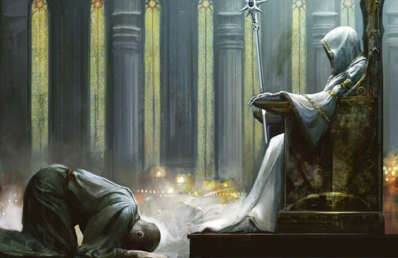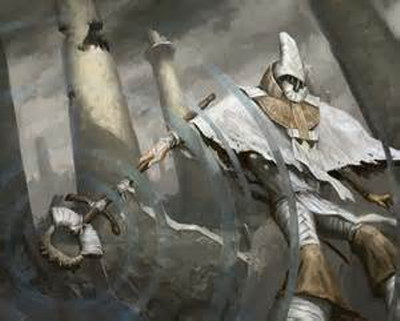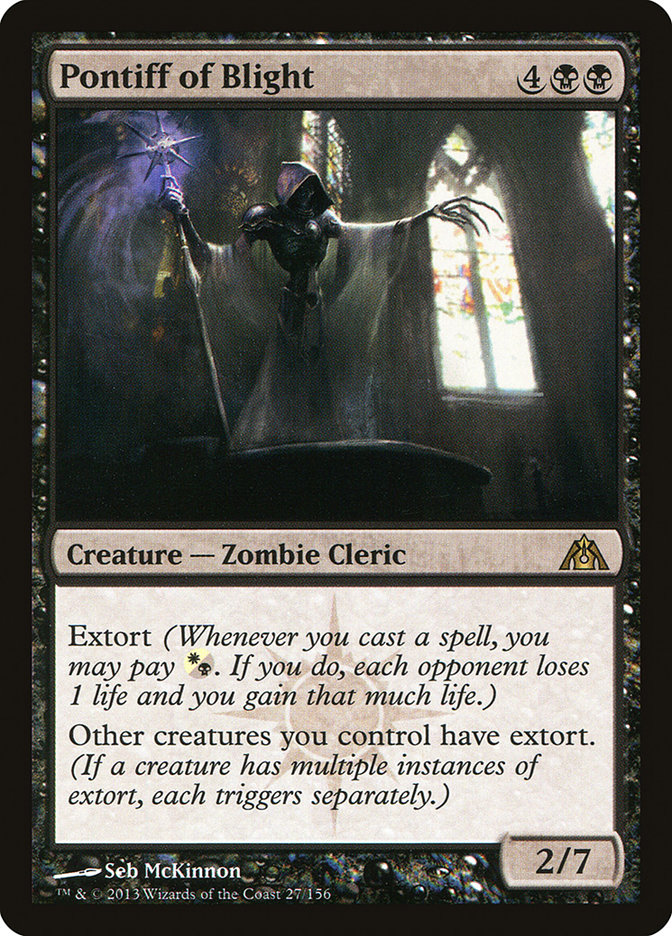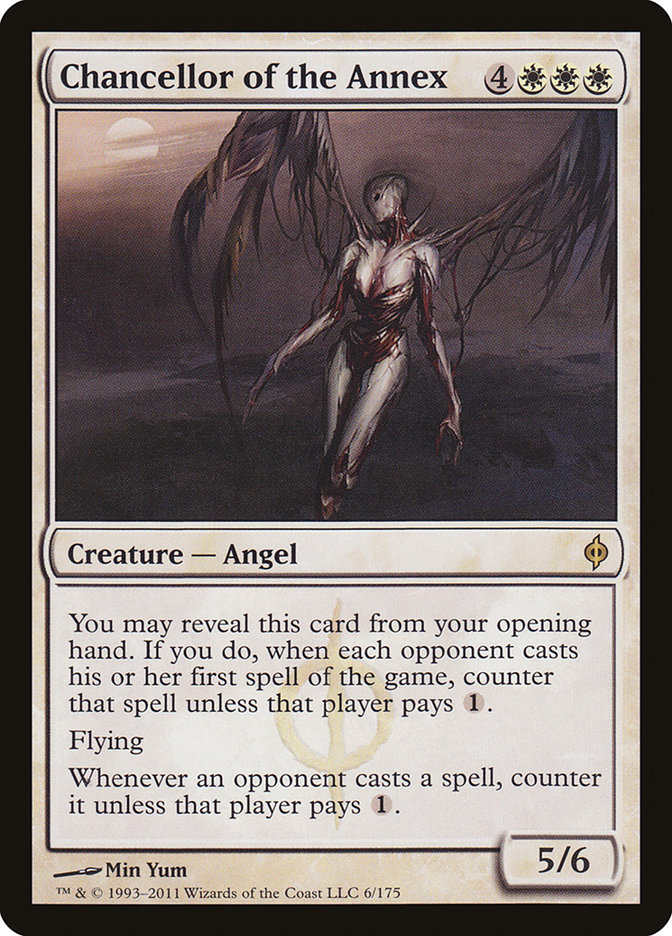April 15th.
In these United States, it’s tax time, which is a time of stress, number crunching, and hurried trips to the post office. There’s always something you forget, some calculation you missed, some document you can’t put your hands on . . .
Oh, you mean you filled yours out months ago when you first got your W-2 in the mail like a responsible human being? Oh, well so did I. Yep.
It’s no secret that we’re in the heart of spoiler season for Journey into Nyx. Everyone’s excited, brewing, and readjusting their collection to be ready to build the second they can get their hands on the new set. There are already some standout cards for me, and I’m noodling on some preliminary lists. But I’d like to wait until the full spoiler drops before I begin brewing for realsies. Until then I’ve got three "holiday" brews in three different formats for you that corner the very narrow market commemorating the day we give to Caesar’s what is Caesar’s.
Lucky for us, Standard offers a mechanic that to some feels very much like taxation: extort.

This nickel and dime mechanic was a lot of fun in Limited and is a big hit with several casual players I know. The ability to cast any spell and pay a little extra to drive your opponent closer to death is admittedly kind of fun. The slow and painful extraction of life offers an intriguing and flavorful path toward a spiffy deck.
If there was an extort "lord," it would be this card from Dragon’s Maze.
Giving all of your creatures extort is pretty exciting; every spell you cast has the potential to flatten your opponent even if it’s a measly removal, draw, or discard spell. The Pontiff combos with all creatures, but there has got to be something interesting and unique we can do with this God blocker.
Perhaps the Pontiff’s greatest weakness is that it’s compared with and utterly trumped by a common from Theros. Grey Merchant of Asphodel is a Pillarfield Ox that at its worst gives you the equivalent of two free extort triggers. At best this Zombie can account for turns and turns of free extortion.
To maximize the Pontiff’s effectiveness, I think we should just use them together.
Creatures (15)
Planeswalkers (4)
Lands (25)
Spells (16)

One of the fun parts about brewing is the opportunity to use cards no one’s talking about, and that’s what we’re looking to do here.
Crypt Ghast, which is kind of a Nykthos, Shrine to Nyx on a stick, has seen very little play and rightfully so. Although it looks outstanding on paper, the Ghast is extremely fragile, and you often cannot cast it on time, lest you get no value out of it if your opponent Shocks it. Only if you cast it on six mana do you effectively cast it for free. However, the rest of the deck supports Crypt Ghast, and it already has an extort trigger stapled to it. Gray Merchant appears as a full set. When would you ever not play the whole set in a mono-black list? On that note, isn’t it crazy to think that our format has been warped around a five-mana common creature? Common removal spells like Lightning Bolt and Mana Leak have a history of changing the way we play Magic, but this is a first in my memory.
Anyway, the Merchant’s less prominent devotion partner, Disciple of Phenax, appears here as a two-for-one removal spell, and Vizkopa Confessor plays a similar role. However, it can rip any card out of your opponent’s hand, though at a hefty life cost, but it has extort to make up for it. Finally, three Pontiffs wrap up the critter list.
The spell suite is typical but not identical to Mono-Black Devotion and B/W Midrange lists of the past. Thoughtseize is particularly strong here because the life loss is easily mitigated even before it resolves if you extort it twice and as such can be a great spell to cast even if your opponent’s hand is empty. Hero’s Downfall, Underworld Connections, and the singleton Whip of Erebos are fairly standard fare, but Orzhov Charm gets a bit more strength. It can let you rebuy a Gray Merchant of Asphodel activation or one of your discard cronies, but it can also unconditionally kill any targetable creature for two mana. Sure, the life cost is significant, but your whole plan is to pick them apart piece by piece and gain a bunch of life off some mundane spell. You’ll get it back!
Elspeth, Sun’s Champion was my original pairing for the Pontiff. Elspeth creates three Soldier tokens, each with extort. You’ll also notice that both pre- and post-board Elspeth’s Smite the Monstrous sweeper doesn’t kill a single creature in this deck. Having a wimpy team can pay off! Liliana of the Dark Realms, who provides noncreature devotion, pump/removal, deck filtering, and an ultimate that extorters dream about, is a rarely utilized planeswalker who seems to have a home here. Crypt Ghast wants a healthy stock of Swamps, and Liliana keeps the lands coming. Finally, Sanguine Bond makes your Gray Merchant and extort triggers all the deadlier while providing a bit of black devotion on the side. With Crypt Ghast, you can cast this on five and cast a Gray Merchant, for what that’s worth!
The only land of note is the Overgrown Tomb, which makes it in here to pay for the sideboarded Deathrite Shaman’s Forest powered ability. With Liliana of the Dark Realms to fetch it, activating the Shaman on time shouldn’t be a concern.
As for the sideboard, Pharika’s Cure has a dual purpose. It’s obviously a great early damage spell, giving it the feeling of Azorius Charm in combat (remove a creature and undo some of their work). If you have Sanguine Bond, it’s just a mini Chandra’s Outrage. Doom Blade is a comfortable option against any nonblack deck, as Courser of Kruphix; Master of Waves; and Brimaz, King of Oreskos are still tough creatures to deal with. Duress is a common sideboard choice these days, and some have even snuck into the maindeck.
Deathrite Shaman along with the extort theme can drain your opponent even when your hand is empty. It’s not right for every matchup, but grindy games will make you grateful there’s a Shaman on your side. The singletons, including an additional Elspeth for control decks, address issues specific to certain decks. Obzedat, Ghost Council, who’s good in many matchups, is still difficult for some decks to beat, though it is too slow or insignificant in other matches. Merciless Eviction hoses certain decks, especially if they’re enchantment or planeswalker centric.
This one is just for fun; it’s no surprise that traditional mono-black decks do a far better job of answering creatures, developing threats, and closing games. However, if you like the idea of defeating your opponent with a death by a thousand stings, give this list a try.
From here we move on to Modern. Modern is probably my pet format to brew in at the moment. I like having so many options, and I like that there’s enough of a metagame and crazy combinations of cards to make for interesting games. There’s tons of buried treasure in the format.
In the spirit of extra costs, let’s start with the first card that gave me this particular concept.
Revealing the Chancellor gives your opponent two options—they can choose to cast a spell that is guaranteed to be countered or can wait an extra turn to cast what they want to. In Modern, this one-turn delay can mean all the difference in the world, so the concept of jamming multiple Chancellors to put them off their first spell for many turns was exciting to me. I lingered on the idea of taxing them not just for their first spell but every spell.
Limiting spells they cast is strong against every deck, and white lends itself well to taxing the opponent. Although there are decks currently being considered that pursue this path, I wanted to particularly oppress noncreature spells. I’m sure aggro has a place in Modern right now, but combo decks a la Storm, Birthing Pod, and Dredge can confound a fair deck’s plan. Thankfully, Modern offers a critical mass of crucial creature-based options, and when you throw them all together, you’ll be able to take down any opponent.
Creatures (36)
- 3 Auriok Champion
- 4 Grand Arbiter Augustin IV
- 1 Sky Hussar
- 4 Simian Spirit Guide
- 3 Aven Mindcensor
- 1 Mistmeadow Witch
- 3 Reveillark
- 4 Thistledown Liege
- 3 Chancellor of the Annex
- 3 Geist of Saint Traft
- 4 Thalia, Guardian of Thraben
- 3 Ephara, God of the Polis
Lands (15)
Spells (9)

I had a little fun with the name, but it’s actually helpful to identify role players too.
Lock: Thalia, Guardian of Thraben; Thorn of Amethyst; Grand Arbiter Augustin IV; Chancellor of the Annex; Aven Mindcensor
The deck’s "locks" act in ways that limit your opponent’s ability to interact with you offensively or defensively by increasing cost or limiting the choices they have.
Thalia, Guardian of Thraben’s impact was critical during her time in Standard. Now she’s got all the makings of a hate-filled powerhouse in a format that loves to draw, filter, and counter. She is a reasonable fighter by herself, and as we’ll see in a second it only gets better. Thorn of Amethyst is a redundant Thalia, and it has the advantage of being played in multiples (at increasing cost of course). Grand Arbiter Augustin IV is the real ace in the whole. Not only does it make life tricky for your opponent who’s just trying to resolve something, but it makes every creature cheaper and some even doubly so. Augustin’s reduction applies twice if the spell is both blue and white. While I wouldn’t call myself a Johnny, I do love casting big guys for less.
Chancellor of the Annex, while keeping your opponent’s spells a bit more expensive, also has the potential to kill them outright; it’s a Mahamoti Djinn too. There aren’t a ton of creatures that can successfully fight and defeat a flying 5/6, so the Chancellor has the potential to finish the job itself. Aven Mindcensor is a critical tool against decks that tutor, even if it’s just through the use of a fetch land. This can severely limit Birthing Pod choices, and it may just be a zero-for-one Wasteland if you’re lucky. This card has spiked significantly in recent months, and I think it’s an exciting card for this deck.
Stock: Reveillark, Auriok Champion, Sky Hussar, Mistmeadow Witch
The "stock" of the deck involves the value generating creatures that while underpowered in combat provide an essential service to the deck.
Reveillark is a key player in the deck. You’ll notice that nearly every creature has two or less power, meaning that when this Elemental gets killed or evoked you’ll be recovering two creatures that will immediately affect the game. Recover Thalia and a Grand Arbiter to lock two of their lands down or get back a pair of Thistledown Liege so you can go on the offensive. There are tons of options with Reveillark, and very few of them will ever be bad. Auriok Champion, which was once Knight of the White Orchid, gives you endless value against both aggressive and burn-based strategies. Stapling a Soul Warden to a small Paladin-en-Vec gives you a tough to kill, tough to block little devotion generator. Fetch and Shock away; the Champ’s got your back.
Sky Hussar is arguably my favorite card in my Modern Peasant Cube; it gives you endless value and is a powerful creature in its own right (at least in the context of Peasant). This lets you tap two innocuous creatures for a free manaless card every turn in an aggro deck! Once you’re ready to cast it (for 1UW, if you’re lucky), you’ll untap your team to block. Mistmeadow Witch was one of my favorite cards in Shadowmoor block, and my U/W Blink deck was a real ringer in college. There’s a lot of creatures that benefit from a blink, whether it’s to rebuy triggered effects or as a form of repeatable protection for your critical pieces. Remember, though, that the creature remains exiled for the whole turn, so don’t get caught unaware!
Barrel: Thistledown Liege; Ephara, God of the Polis; Geist of Saint Traft; Simian Spirit Guide
Finally, the "barrels" of the deck involve the spells that take you way over the top when it’s time to close the game or press your position.
Thistledown Liege is a really good anthem. It can do battle itself and is exponentially powerful in multiples, and you can cast it at your opponent’s end step or mid-combat. The Liege once shown will mess with your opponent’s combat for the entire match. It costs just three mana with Augustin IV’s reduction, and every creature benefits from at least half of it. Many benefit from both halves. Ephara, God of the Polis, is my favorite God from Born of the Gods. There’s tons of potential for use and abuse here, and the deck is crafted in such a way that her steep seven devotion requirement will be frequently met. Even the aforementioned Liege provides three towards that goal, and it makes her an 8/7. Furthermore, Augustin IV makes her cost a paltry UW!
Geist of Saint Traft is the hard to kill powerhouse we loved knew in last year’s Standard, and thanks to Augustin IV and the Liege this two-mana pounder can hit for nine on one swing. Finally, Simian Spirit Guide can push out your "locks’ more quickly. The deck’s draw power is sufficient to allow a playset of this Lotus Petal in, and getting your answer out one turn early is often the difference between your opponent going off or not. Imagine the sick opener of Chancellor, Guide, Guide, Guide, land, land, Thalia. Reveal the Chancellor, cast your Thalia on turn 1, draw Augustin, and cast him on turn 2. Win target game!
The land base is heavily white obviously, and I’ve included one Sacred Foundry just in case Simian Spirit Guide needs to actually fight.
Fifteen creatures fill the sideboard, each with a particular mission should it come in. Meddling Mage is a great two-mana answer for any combo piece. Moreover, thanks to Thistledown Liege, you don’t even have to call Lightning Bolt; the Liege alone is enough to protect it! Similarly, Fiend Hunter is a good exiler that can be protected from Lightning Bolt by a Liege, and in this format being a Banisher Priest is a liability. Grand Abolisher helps you fight through counter decks, and it makes many activities your opponents do during your end step an awkward main phase affair. Imposing Sovereign is an anti-haste, anti Splinter Twin card. It’s helpful in aggressive matchups too, preventing them from making meaningful blockers in time.
Spirit of the Labyrinth is another great tool to stop digging decks. Faithless Looting, Serum Visions, Gitaxian Probe, and Manamorphose (read: the Storm deck) all get smashed by an on-time Spirit. Finally, a single Eight-and-a-Half-Tails makes the cut. I remember pulling my own copy almost ten years ago and treasuring it dearly. Everyone in my playgroup wanted it, and now I want it here. Given enough mana, you can protect any creature from anything. Heavy removal deck? Eight-and-a-Half-Tails. Trouble breaking through a massive line of defenders? Eight-and-a-Half-Tails. It doesn’t even need the other half.
This deck seems very exciting to me; what originally began as a silly endeavor grew into something powerful and interesting. Maybe it’s got some legs? I’ll be testing it out, and I’ll let you all know how it goes.
But wait! I’ve got one more deck for you! Maybe your taxes have driven you to the edge; the anger that fills your heart and soul have finally pushed you off the cliff of society, and you’re ready to act. Fight the power and suit up with Rebels!

The "recruitment" feature of many Rebels can create a fun casual deck to play with your friends. Not too powerful, but not boring either. Maybe you need a bit of mutiny in your game?
Creatures (27)
- 1 Cho-Manno, Revolutionary
- 2 Ballista Squad
- 2 Lin Sivvi, Defiant Hero
- 1 Lightbringer
- 1 Lawbringer
- 3 Defiant Vanguard
- 2 Reveille Squad
- 3 Children of Korlis
- 4 Knight of the Holy Nimbus
- 3 Big Game Hunter
- 1 Dunerider Outlaw
- 2 Rathi Trapper
- 2 Ramosian Revivalist
Lands (18)
Spells (16)

This little number is chocablock with thirty Rebels, all ready for combat! Rebels themselves provide critical searchable tools to effectively destroy your opponents. Protection for green, black, and red, as well as a Smite the Monstrous is at your fingertips.
In the spell category, Shared Triumph is a cheaper Glorious Anthem at just two mana! Bound in Silence is a searchable recoverable instant removal spell. Heartstone helps curb your recruitment costs as much as possible, letting you search up new recruits as often as possible. Thousand-Year Elixir also lets you search right away, and you can get two searches off one, letting you recover quickly if the battlefield is wiped clean.
Perhaps the best part about this deck is its cost. As of now, excluding the color-producing land base, every card in this deck costs $1.99 or less on StarCityGames.com. Even if every card (including the lands) were $2.00, you’d still only be paying $120.00 for a complete deck, and many of these cards are much cheaper than that. You can use your tax return to fight the power! Regarding the rest of the land base, which is clearly fairly expensive, you can replace the Godless Shrine and Fetid Heaths with Orzhov Guildgates, Orzhov Basilicas, Isolated Chapels, or just good ol’ Plains and Swamps for an even deeper discount. Other more expensive cards like Eldrazi Monument, Coat of Arms, and Gauntlet of Power are great additions too if you’ve got them!
Hopefully one of these archetypes fits you, whether it’s the slow and purposeful dissolution of life, the oppressive and aggressive power-grabber, or the intrepid and anti-establishment vigilante. I hope you’ll give one of these a shot based on your taste.
If you had to make a deck based around these concepts, how would yours look?


